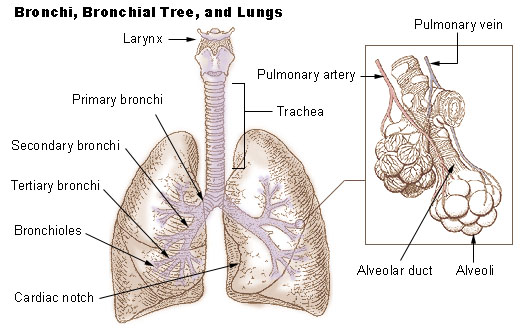Introduction
Respiration releases energy for life processes to carry on. Aerobic respiration happens in the presence of oxygen, while anaerobic respiration doesn’t require oxygen. Therefore, the human respiratory is specifically designed to enable gaseous exchange.
The respiratory tract is the pathway of air from the nose to the lungs and is divided into:
- Upper Respiratory Tract– includes nostrils, pharynx, nasal cavities, epiglottis, and larynx.
- Lower Respiratory Tract– includes trachea, bronchioles, bronchi, and lungs.
Functions of the respiratory system.
- Regulation of blood pH.
- Control of body temperature.
- Defense against germs.
Ventilation.
The gaseous exchange between the external environment and alveoli is called ventilation. From an area of high pressure to low pressure, air moves by bulk flow. Depending on the pressure in the alveoli, air moves in or out of the lungs. The body alters the pressure in the alveoli by changing lung volume, whereby as volume increases, pressure decreases, and vice versa.

Pathway of gases.

Air breathed in is composed of gases in different quantities where oxygen (21%),nitrogen (78%), CO2 (0.04%) and others with insignificant portions. The gases enter the nasal cavities where it is filtered by hairs and mucus in the nostril. The mucus traps pollen, dust, and fine particles.
The air then travels through the pharynx, a funnel-shaped tube connecting nasal cavities to the larynx. The epiglottis closes to prevent food and drinks from entering the trachea, which is harmful, thus protecting it. The larynx also acts as the voice box whereby air is passed over the vocal cords producing vibrations used to form sound.
The air enters the windpipe lined with mucous secreting cells and held by c-shaped cartilage rings that keep it always open for the passage of gases. The unwanted particles are trapped by the mucus whereby the cilia helps propel them backward the trachea walls for either swallowing or coughing out.
Here the air goes through bronchi, bronchioles, and alveoli to enter the pulmonary capillaries.
Inspiration.
Inhalation otherwise called inspiration is the taking in of air. During this process, the diaphragm contracts pulling downwards while the ribs contract pulling upwards. This causes the increase of the thoracic cavity decreasing the pressure in the chest cavity. Air, therefore, rushes in to fill the lungs due to pressure difference with the atmosphere.
Expiration.
Also called exhalation, air travels out of the body. The diaphragm relaxes, thus decreasing the volume of the chest cavity. The decrease in volume causes an increase in pressure. The ribcage also relaxes to create a positive pressure whereby the pressure in the lungs is higher than the atmospheric pressure,thereby forcing the air out.
